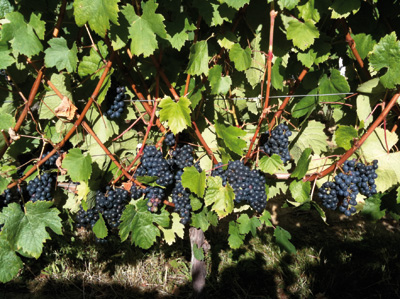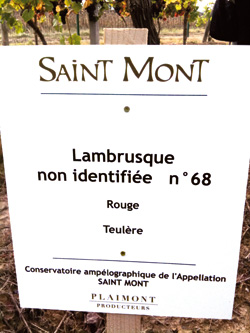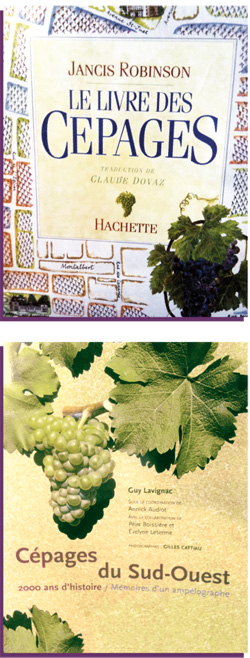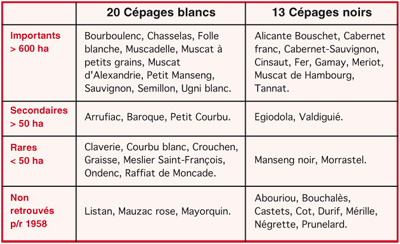Cépages Gers
Ampelography
BACK TO THE FUTURE
Since 2002, the Producteurs de Plaimont in the Gers, in the appellations Saint-Mont, Pacherenc de Vic-Bilh, and Madiran, follow the progress of the ampelographic works proceeded on old or unknown varietals listed by a conservation institute… Back to the past to better comprehend the future…

In the 70/80s, Jean-Paul Houbart, technician in the cellar of Plaimont, started to register old vine trunks and to preserve varieties like the Tannat Meunier, the Tannat Quillard or the Miousap. In 1999 this work took a more scientific turn with the participation of the ENTAV*, the Onivins, the INRA and the Chamber of Agriculture of the Pyrénées-Atlantiques. A prospection has been undergone over some ten plots, especially on a prephylloxeric one with non-grafted stocks. Since 2002, on 63 ares, 5,002 stocks have been planted. Forty varieties have been spotted: 11 varietals have been recognized after genetic identification and recorded in the French catalogue, 9 others are still present in the memories but nearly forgotten, 6 are listed but “forgotten”, 11 are unknown, one is wild (Lambrusque) and 2 are not identified.

This treasure, on which the Producers of the cellar keep a close eye, in partnership with eminent researchers and public research centres, experienced the 2010 harvest. For the third year in a row, micro-vinifications operated with these ancestral varietals will enable to detect those that will bring even more richness in the blends of the Saint-Mont appellation.
Preserve this heritage, develop it by recording new varieties or clones in the official catalogue, would give the wine growers the opportunity to mark the typicity of the local production, but also to adapt to climatic changes, or even to reduce inputs by adopting more disease-resistant young vines. Conservation allows family connection research, especially via DNA, but also the enlargement of the possibilities of varietal creation. Today, the adjustment of biochimical methods of identification—genetic and by phenotype coding—confirms or contradicts the results obtained through morpholigical observations. Two unknown varietals are closely followed for their quality: the "Dubosc Plant nr.1" in red and the “Pedebernade 4 Rosé” in white. Before they are used they will have to be named. The next step will be, like for every new interesting varietal, the registration in the varietal catalogue (with a minimum waiting time of six years) or the selection of local origins of known varieties (8-years waiting time).
In 2006, 20 sorts of vine represented 86% of the French vineyard, against 53% in 1958. At the same time, secondary varietals have disappeared. The biodiversity transmitted by our ancestors and studied in this conservation institute could be a real slap in the face for the simplification of the current varieties, more productive and trendy, to enrich the blends of the wines of the Southwest of France.
F. Varaine
* Etablissement National Technique pour l’Amélioration de la Viticulture.

Varietals :
- 6.000 cépages actuellement connus dans le monde,
- 500 recensés en France (150 dans le Sud-Ouest),
- 325 autorisés à la plantation.
Other conservation institutes :
- Domaine de Vassal à Marseillan, dans l’Hérault.
- La collection de l’Espiguette au Grau du Roi.
- Tableau des cépages répertoriés et reconnus
du conservatoire du Saint-Mont.
DNA and genomes
Cabernet Sauvignon: recognized by molecular marking as stemming from crossing between the Cabernet Franc and the Sauvignon Blanc.
Cabernet Franc: synonymous with Bouchy, Bouchet, Trouchet, Acheria in Irouléguy, Couahort in Béarn, Capbreton Rouge in the Landes, and Breton in Val de Loire.
Fer Servadou: close to the Cabernet Franc family. Synonymous with Pinenc, Braucol in Gaillac, Mansois in Marcillac, Estrons in the Lot.

Tannat: red varietal of Madiran, Saint-Mont, Béarn and Irouléguy. Called Bordelez Beltza in Basque. The origin of the name comes from the Occitan Bordalès, that is “Metairie”, having given bordaler (sharecropper), the word borde meaning “barn” in the Béarn.
Merlot: crossing between Cabernet Franc and Magdelaine Noire des Charentes.
Base de donnée des cépages:
www.eu-vitis.de In the 70/80s, Jean-Paul Houbart, technician in the cellar of Plaimont, started to register old vine trunks and to preserve varieties like the Tannat Meunier, the Tannat Quillard or the Miousap. In 1999 this work took a more scientific turn with the participation of the ENTAV*, the Onivins, the INRA and the Chamber of Agriculture of the Pyrénées-Atlantiques. A prospection has been undergone over some ten plots, especially on a prephylloxeric one with non-grafted stocks. Since 2002, on 63 ares, 5,002 stocks have been planted. Forty varieties have been spotted: 11 varietals have been recognized after genetic identification and recorded in the French catalogue, 9 others are still present in the memories but nearly forgotten, 6 are listed but “forgotten”, 11 are unknown, one is wild (Lambrusque) and 2 are not identified.
In the 70/80s, Jean-Paul Houbart, technician in the cellar of Plaimont, started to register old vine trunks and to preserve varieties like the Tannat Meunier, the Tannat Quillard or the Miousap. In 1999 this work took a more scientific turn with the participation of the ENTAV*, the Onivins, the INRA and the Chamber of Agriculture of the Pyrénées-Atlantiques. A prospection has been undergone over some ten plots, especially on a prephylloxeric one with non-grafted stocks. Since 2002, on 63 ares, 5,002 stocks have been planted. Forty varieties have been spotted: 11 varietals have been recognized after genetic identification and recorded in the French catalogue, 9 others are still present in the memories but nearly forgotten, 6 are listed but “forgotten”, 11 are unknown, one is wild (Lambrusque) and 2 are not identified. 

